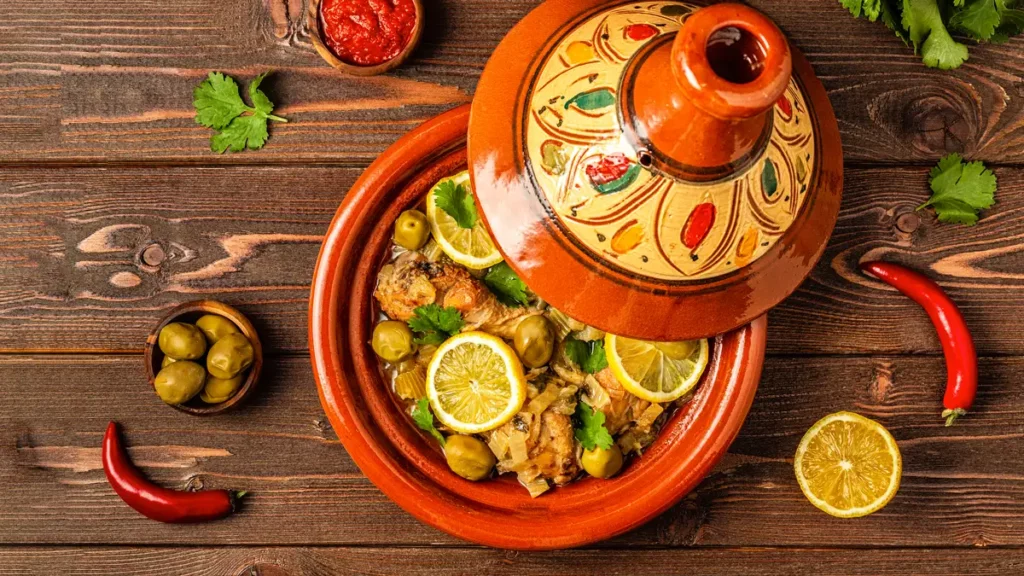What is a tagine in Morocco?
A tagine is a traditional Moroccan dish named after the earthenware pot used to cook it. The pot has a conical lid that traps steam, allowing the food to cook slowly and retain moisture. This unique method results in tender, flavorful meals that are a staple of Moroccan cuisine.
History of the Tagine
The Berbers initially used the tagine as a portable oven, and its design has remained largely the same for centuries. Made from clay, the tagine pot imparts an earthy flavor to food. Traditionally, cooking with a tagine involves placing it over coals or an open flame. However, modern tagines can be used on stovetops or in ovens.
Usability and Cooking Process
Cooking with a tagine is straightforward but requires patience. The process begins with layering ingredients, starting with meat or fish, followed by vegetables, and then adding spices, herbs, and liquids like broth or water. The conical lid ensures even cooking by allowing steam to circulate. This slow-cooking method melds the flavors together beautifully, creating a rich and aromatic dish.
Popular Tagine Varieties
There are numerous varieties of tagine, each with its unique combination of ingredients and flavors:
– Chicken Tagine with Preserved Lemons and Olives: A classic Moroccan dish known for its bright, tangy flavor.
– Lamb Tagine with Prunes and Almonds: A sweet and savory dish, often served on special occasions.
– Vegetable Tagine: A popular option for vegetarians, featuring seasonal vegetables, spices, and sometimes dried fruits like apricots or raisins.
Health Benefits
Tagine dishes are generally healthy, as they include a variety of vegetables, lean meats, and aromatic spices. The slow-cooking process helps retain nutrients, and healthy fats like olive oil enhance the nutritional value. Additionally, the absence of heavy creams or processed ingredients makes tagine a wholesome meal option.
How the Moroccan Tagine Pot is Made
The Moroccan tagine pot is crafted from clay, which is often mixed with water to create a pliable dough. Artisans shape the dough into the base and conical lid by hand or using a potter’s wheel. After shaping, the pot is left to dry in the sun before being fired in a kiln to harden. Some tagines are then glazed to add color and protect the clay, while others remain unglazed, maintaining a rustic look. This process ensures the tagine’s durability and ability to impart an earthy flavor to the food cooked in it.
Cultural Significance
Tagine is more than just a dish; it symbolizes Moroccan hospitality and communal eating. Meals are often shared directly from the tagine pot, with family and friends gathering to enjoy the food together. This tradition fosters a sense of community and togetherness.
Serving and Eating Moroccan Tagine
In Morocco, tagine is typically served with khobz, a Moroccan flatbread used to scoop up the food. It is also paired with couscous, which absorbs the rich, flavorful sauce. Eating with hands is common, enhancing the communal dining experience. It’s customary to use the right hand when eating.
Does Food Taste Different in a Tagine?
Yes, food cooked in a tagine tastes different due to the unique cooking method. The clay pot and conical lid allow the food to cook slowly, preserving moisture and enhancing flavors. The result is tender meat and vegetables infused with a rich blend of spices and herbs.
Ready to Try Moroccan Tagine?
Are you interested in experiencing the flavors of Morocco? Join one of our private tours and enjoy authentic Moroccan tagine prepared by local chefs. Book your tour with us now and dive into Morocco’s rich culinary traditions. Also, check out our articles on the best places to visit in Morocco and safety tips in Morocco to plan your perfect trip.
If you have any questions about Morocco, feel free to contact us via email or WhatsApp.






